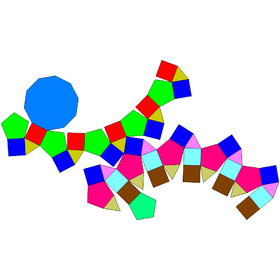| Paragyrate diminished rhombicosidodecahedron | |
|---|---|
 | |
| Type | Johnson J76 – J77 – J78 |
| Faces | 3x5 triangles 3x5+10 squares 1+2x5 pentagons 1 decagon |
| Edges | 105 |
| Vertices | 55 |
| Vertex configuration | 10(4.5.10) 10(3.42.5) 3x5+2.10(3.4.5.4) |
| Symmetry group | C5v |
| Dual polyhedron | - |
| Properties | convex |
| Net | |
 | |
In geometry, the paragyrate diminished rhombicosidodecahedron is one of the Johnson solids (J77). It can be constructed as a rhombicosidodecahedron with one pentagonal cupola rotated through 36 degrees, and the opposing pentagonal cupola removed.
A Johnson solid is one of 92 strictly convex polyhedra that is composed of regular polygon faces but are not uniform polyhedra (that is, they are not Platonic solids, Archimedean solids, prisms, or antiprisms). They were named by Norman Johnson, who first listed these polyhedra in 1966.[1]
External links
[edit]- ^ Johnson, Norman W. (1966), "Convex polyhedra with regular faces", Canadian Journal of Mathematics, 18: 169–200, doi:10.4153/cjm-1966-021-8, MR 0185507, Zbl 0132.14603.